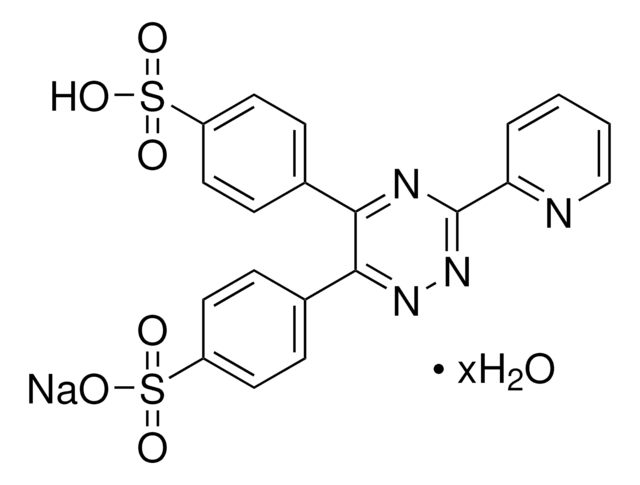372870
Iron(II) chloride
98%
Sinónimos:
Ferrous chloride, Iron dichloride
About This Item
Productos recomendados
Nivel de calidad
Ensayo
98%
Formulario
powder
idoneidad de la reacción
core: iron
reagent type: catalyst
reaction type: Atom Transfer Radical Polymerization (ATRP)
características de los productos alternativos más sostenibles
Catalysis
Learn more about the Principles of Green Chemistry.
sustainability
Greener Alternative Product
mp
677 °C (lit.)
densidad
3.16 g/mL at 25 °C (lit.)
categoría alternativa más sostenible
, Aligned
cadena SMILES
Cl[Fe]Cl
InChI
1S/2ClH.Fe/h2*1H;/q;;+2/p-2
Clave InChI
NMCUIPGRVMDVDB-UHFFFAOYSA-L
¿Está buscando productos similares? Visita Guía de comparación de productos
Descripción general
Aplicación
- The preparation of Grignard compounds, such as 1-naphthylmagnesium chloride.
- The selective oxidation of 2,4,6-trimethylphenol (2,4,6-TMP) to 3,5-dimethyl-4-hydroxybenzaldehyde (DMHB) in the presence of acetoxime.
- Raney-type catalysts modified with FeCl2 show enhanced selective hydrogenation of an α,β-unsaturated aldehyde to an unsaturated alcohol.
Palabra de señalización
Danger
Frases de peligro
Consejos de prudencia
Clasificaciones de peligro
Acute Tox. 4 Oral - Eye Dam. 1
Código de clase de almacenamiento
8B - Non-combustible corrosive hazardous materials
Clase de riesgo para el agua (WGK)
WGK 1
Punto de inflamabilidad (°F)
does not flash
Punto de inflamabilidad (°C)
does not flash
Equipo de protección personal
Eyeshields, Faceshields, Gloves, type P3 (EN 143) respirator cartridges
Elija entre una de las versiones más recientes:
Certificados de análisis (COA)
¿No ve la versión correcta?
Si necesita una versión concreta, puede buscar un certificado específico por el número de lote.
¿Ya tiene este producto?
Encuentre la documentación para los productos que ha comprado recientemente en la Biblioteca de documentos.
Los clientes también vieron
Artículos
Micro review of reversible addition/fragmentation chain transfer (RAFT) polymerization.
Micro review of reversible addition/fragmentation chain transfer (RAFT) polymerization.
Micro review of reversible addition/fragmentation chain transfer (RAFT) polymerization.
Micro review of reversible addition/fragmentation chain transfer (RAFT) polymerization.
Protocolos
We presents an article featuring procedures that describe polymerization of methyl methacrylate and vinyl acetate homopolymers and a block copolymer as performed by researchers at CSIRO.
We present an article about RAFT, or Reversible Addition/Fragmentation Chain Transfer, which is a form of living radical polymerization.
Polymerization via ATRP procedures demonstrated by Prof. Dave Haddleton's research group at the University of Warwick.
Polymerization via ATRP procedures demonstrated by Prof. Dave Haddleton's research group at the University of Warwick.
Nuestro equipo de científicos tiene experiencia en todas las áreas de investigación: Ciencias de la vida, Ciencia de los materiales, Síntesis química, Cromatografía, Analítica y muchas otras.
Póngase en contacto con el Servicio técnico











